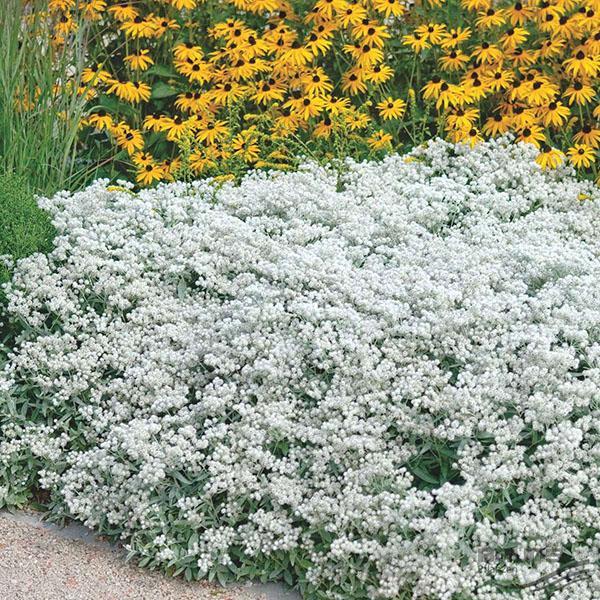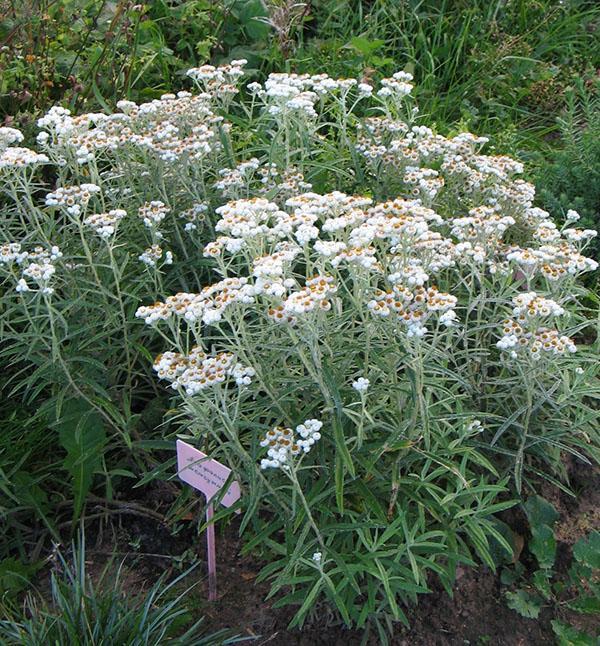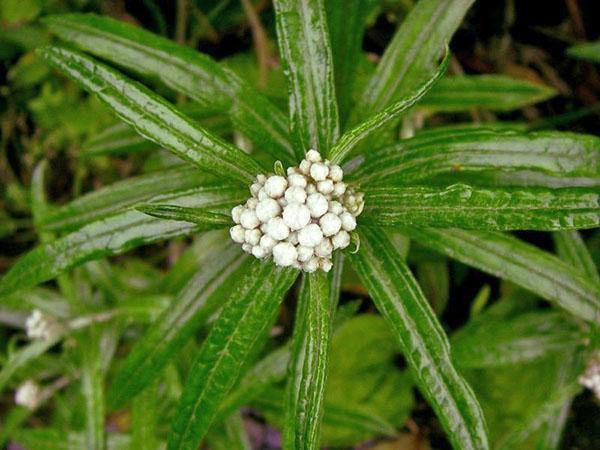Pearl necklace for the garden - anafalis
 To give their garden uniqueness and charm, many growers grow anaphalis. They fell in love with him for his delicate inflorescences, reminiscent of a pearl necklace, for his unpretentious disposition and ease of care. A close acquaintance with this plant will help you appreciate it.
To give their garden uniqueness and charm, many growers grow anaphalis. They fell in love with him for his delicate inflorescences, reminiscent of a pearl necklace, for his unpretentious disposition and ease of care. A close acquaintance with this plant will help you appreciate it.
Attractive appearance

The stem of the plant is covered with white hairs along its entire length. It is they who give anathalis an unusual shade. Hence the name of this variety - pearl. It grows up to 50 cm.Dwarf species up to 30 cm high are especially appreciated by flower growers.
 Inflorescences with small white flowers appear at the top of the stately stem in the warm season. Usually they do not exude aroma, but attention is drawn to them by a basket woven from dry leaves. In the center of the inflorescence are delicate yellow tubes. They stand out gracefully against a white background.
Inflorescences with small white flowers appear at the top of the stately stem in the warm season. Usually they do not exude aroma, but attention is drawn to them by a basket woven from dry leaves. In the center of the inflorescence are delicate yellow tubes. They stand out gracefully against a white background.
Anaphalis has elongated leaves, the upper part of which branches out. From the inside, they are painted in a grayish color, which is truly delightful.
The first inflorescences of anaphalis appear already at the beginning of June. The last flowers disappear in September. If there is a desire to admire the lush decoration of the garden all summer long, then anafalis is an excellent choice.
The peculiarity of this garden decoration is the root system that can quickly sprout. Every year it increases to 30 cm. Thanks to this, the anafalis plant is not afraid of weeds. Experienced flower growers use these pearl necklaces to protect their sites. Nice and useful.
Popular types of anaphalis
For several decades Russian flower growers have been touched by the beauty of this garden pearl. Its delicate clusters of miniature flowers with rustling leaves attract more than one generation.
In ancient times, anaphalis was used for medicinal purposes. Even today, it is found in some medicines. Although in nature there are many species of this plant, there are not so many cultivated ones. The following varieties are popular:
- pearl;
- three-veined;
- Nepali;
- cystic.
The photos of anaphalis presented below help to see the plant in all its glory.
 Anafalis pearl migrated to Russia from the northern part of the American continent. It grows up to 40 cm in height. The stems of the plant and many linear leaves are covered with a silvery white felt down. Flowers, in the form of baskets, are collected in inflorescences located at the very top of the shoots. They consist of miniature white flowers, around which there are several rows of dry leaves.
Anafalis pearl migrated to Russia from the northern part of the American continent. It grows up to 40 cm in height. The stems of the plant and many linear leaves are covered with a silvery white felt down. Flowers, in the form of baskets, are collected in inflorescences located at the very top of the shoots. They consist of miniature white flowers, around which there are several rows of dry leaves.
This variety is not afraid of cold weather, therefore it comfortably survives the winter period.
 Anafalis three-veined descended into our flower beds from the height of the Himalayan mountains. Accustomed to growing on rocky soil, it thrives on fertile soil.
Anafalis three-veined descended into our flower beds from the height of the Himalayan mountains. Accustomed to growing on rocky soil, it thrives on fertile soil.
This perennial plant can grow up to 50 cm. Its stem is straight with lanceolate leaves, grayish. Inflorescences of white color with a delicate silver tint are in pearl capsules at the tops of erect stems.
 The birthplace of Nepalese anaphalis is the high-mountain glades of the famous mountains. It grows up to 30 cm. The leaves, located at the roots, have an oval oblong shape.Those on the shoots are narrowed to the brim with a white edge.
The birthplace of Nepalese anaphalis is the high-mountain glades of the famous mountains. It grows up to 30 cm. The leaves, located at the roots, have an oval oblong shape.Those on the shoots are narrowed to the brim with a white edge.
Inflorescences beige or white grow in the form of brushes from 1 to 15 pieces. Anaphalis blooms in late summer.
 The cystic type of anaphalis has especially large inflorescences. They often reach up to 1.5 cm in diameter. It is for this beauty that this type of anaphalis is valued. It is extremely rare, therefore it is considered an exclusive species.
The cystic type of anaphalis has especially large inflorescences. They often reach up to 1.5 cm in diameter. It is for this beauty that this type of anaphalis is valued. It is extremely rare, therefore it is considered an exclusive species.
Planting and caring for a pearl beauty
 Since anaphalis is used to growing in extreme conditions, even an amateur gardener can grow it. And then he will decorate the flower garden until the fall. Dried buds are useful for home decor.
Since anaphalis is used to growing in extreme conditions, even an amateur gardener can grow it. And then he will decorate the flower garden until the fall. Dried buds are useful for home decor.
When planting pearl anaphalis and caring for it, it is important to consider the following points:
- this plant is perennial;
- drought resistant;
- loves sunny areas of the garden;
- prefers well-drained soil.
As you can see, the rules are not difficult to grow a pearl beauty in your own front garden.
When the plant takes root, do not over-water it. This can lead to the death of anaphalis, which is very sad.
You can plant a plant in three ways: by sowing seeds, by cuttings and dividing the bush.
Sowing seeds
 Anaphalis seeds are small in size, so they are mixed with coarse sand before sowing. Then they are carefully laid out on the ground in small containers, without sprinkling them with earth. The next step is to cover the container with glass and spray regularly. When shoots appear, dive them into boxes or pots... Plant seedlings in September.
Anaphalis seeds are small in size, so they are mixed with coarse sand before sowing. Then they are carefully laid out on the ground in small containers, without sprinkling them with earth. The next step is to cover the container with glass and spray regularly. When shoots appear, dive them into boxes or pots... Plant seedlings in September.
Cuttings
Reproduction takes place from late spring to September. To do this, take cuttings no longer than 10 cm, which are cut from the bottom 1 cm from the kidney, and from the top 2 cm above it. Only the top two leaves are left, the rest are cut off. Cuttings are planted in sand, covering the container with glass or film.
In winter, cuttings should be kept in a cool room, protected from frost.
In the spring, when the cuttings take root, they are planted in the garden.
Dividing the bush
 The breeding method of anaphalis by dividing the bush is carried out in spring or late autumn. To do this, a bush is dug up, cut into pieces, trying to preserve a root and a stem in each. After that, the plant can be planted in the prepared place.
The breeding method of anaphalis by dividing the bush is carried out in spring or late autumn. To do this, a bush is dug up, cut into pieces, trying to preserve a root and a stem in each. After that, the plant can be planted in the prepared place.
When the plant takes root in the backyard, it is easy to care for it. There are few weeds near it, so there is no need to weed it often. It is comfortable to tolerate drought, which means you need to water it in moderation. And since he is not afraid of frost, he can not be covered for the winter.
Basic anaphalis care includes regular fall pruning. It is done at the root, level with the ground. And also once every 5 years, the bushes should be thinned.
The plant is rarely sick or affected by pests. Therefore, it will almost always decorate the home area with its lush flowering.